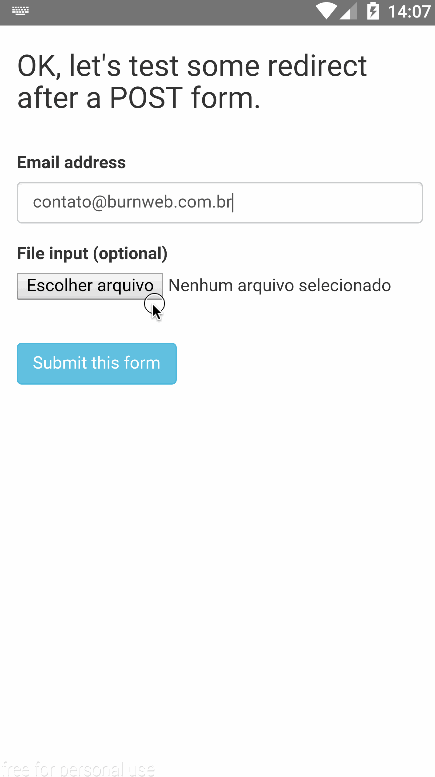Simple React Native Android module to use Android's WebView inside your app (with experimental html file input support to handle file uploads in forms).
npm install react-native-webview-android --save- In
android/setting.gradle
...
include ':RNWebView', ':app'
project(':RNWebView').projectDir = new File(rootProject.projectDir, '../node_modules/react-native-webview-android/android')- In
android/app/build.gradle
...
dependencies {
...
compile project(':RNWebView')
}- Register Module - RN >= 0.29 (in MainApplication.java)
import com.burnweb.rnwebview.RNWebViewPackage; // <--- import
public class MainApplication extends Application implements ReactApplication {
......
@Override
protected List<ReactPackage> getPackages() {
return Arrays.<ReactPackage>asList(
new MainReactPackage(),
new RNWebViewPackage()); // <------ add this line to your MainApplication class
}
......
}If you need to see the install instructions for older React Native versions look here.
var React = require('react-native');
var { StyleSheet } = React;
var WebViewAndroid = require('react-native-webview-android');
var SITE_URL = "https://www.google.com";
var WebViewAndroidExample = React.createClass({
getInitialState: function() {
return {
url: SITE_URL,
// OR
// you can use a source object like React Native Webview.
// source {uri: string, method: string, headers: object, body: string}, {html: string, baseUrl: string}
// Loads static html or a uri (with optional headers) in the WebView. <Just like React Native's version>
// source: {
// uri: SITE_URL,
// headers: {
// ...
// },
// },
status: 'No Page Loaded',
backButtonEnabled: false,
forwardButtonEnabled: false,
loading: true,
messageFromWebView: null
};
},
goBack: function() {
// you can use this callback to control web view
this.refs.webViewAndroidSample.goBack();
},
goForward: function() {
this.refs.webViewAndroidSample.goForward();
},
reload: function() {
this.refs.webViewAndroidSample.reload();
},
stopLoading: function() {
// stops the current load
this.refs.webViewAndroidSample.stopLoading();
},
postMessage: function(data) {
// posts a message to web view
this.refs.webViewAndroidSample.postMessage(data);
},
evaluateJavascript: function(data) {
// evaluates javascript directly on the webview instance
this.refs.webViewAndroidSample.evaluateJavascript(data);
},
injectJavaScript: function(script) {
// executes JavaScript immediately in web view
this.refs.webViewAndroidSample.injectJavaScript(script);
},
onShouldStartLoadWithRequest: function(event) {
// currently only url & navigationState are returned in the event.
console.log(event.url);
console.log(event.navigationState);
if (event.url === 'https://www.mywebsiteexample.com/') {
return true;
} else {
return false;
}
},
onNavigationStateChange: function(event) {
console.log(event);
this.setState({
backButtonEnabled: event.canGoBack,
forwardButtonEnabled: event.canGoForward,
url: event.url,
status: event.title,
loading: event.loading
});
},
onMessage: function(event) {
this.setState({
messageFromWebView: event.message
});
},
javascriptToInject: function () {
return `
$(document).ready(function() {
$('a').click(function(event) {
if ($(this).attr('href')) {
var href = $(this).attr('href');
window.webView.postMessage('Link tapped: ' + href);
}
})
})
`
},
render: function() {
return (
<WebViewAndroid
ref="webViewAndroidSample"
javaScriptEnabled={true}
geolocationEnabled={false}
builtInZoomControls={false}
injectedJavaScript={this.javascriptToInject()}
onShouldStartLoadWithRequest={this.onShouldStartLoadWithRequest}
onNavigationStateChange={this.onNavigationStateChange}
onMessage={this.onMessage}
url={SITE_URL} // or use the source(object) attribute...
style={styles.containerWebView} />
);
// other attributes: source(object), html(string), htmlCharset(string), baseUrl(string), injectedJavaScript(string), disableCookies(bool), disablePlugins(bool), userAgent(string)
}
});
var styles = StyleSheet.create({
containerWebView: {
flex: 1,
}
});This module has a working implementation of onShouldStartLoadWithRequest. However, the event it returns currently only includes url and navigationState.
This module implements an experimental support to handle file input in HTML forms for upload files. It was tested in some Android versions 4.1+, but it's possible that some device won't work OK with that new feature.
To work with some html5 video player inside your Webview, I recommend you to set the android:hardwareAccelerated="true" in your AndroidManifest.xml file.
More info here: http://stackoverflow.com/questions/17259636/enabling-html5-video-playback-in-android-webview
MIT



